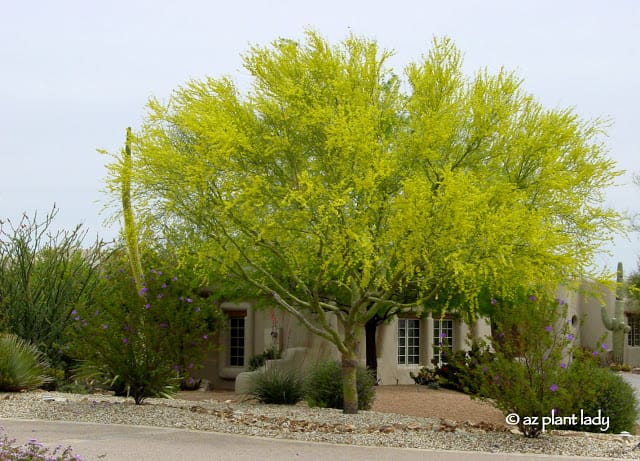
Iconic tree, Blue Palo Verde (Parkinsonia florida)
When people think of the Sonoran desert, hillsides studded with saguaro cactus and cholla often come to mind. But interspersed between the cactus, you will find the palo verde, an iconic tree with their beautiful green trunks and branches.
An Iconic Desert Tree; The Palo Verde
The word “Palo Verde” means “green stick” in Spanish, referring to their green trunk, which is a survival mechanism in response to drought.
Palo verde trees are “drought deciduous,” which means that they will drop their leaves in response to a drought situation. Their green trunks and branches can carry on photosynthesis, even in the absence of leaves.
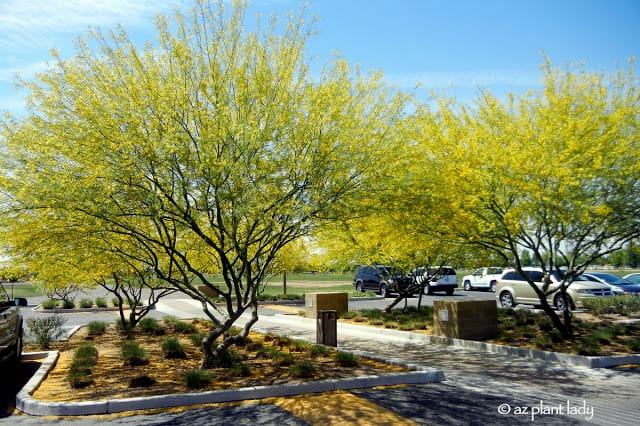
‘Desert Museum’ Palo Verde (Parkinsonia hybrid ‘Desert Museum’)
Palo Verde Trees Are Nurse Plants to Saguaro Cacti
Palo verde trees act as a “nurse plant” to young saguaro cacti by protecting them from the cold in the winter and from the intense sun in the summer. Beautiful, yellow flowers are the product in the spring.
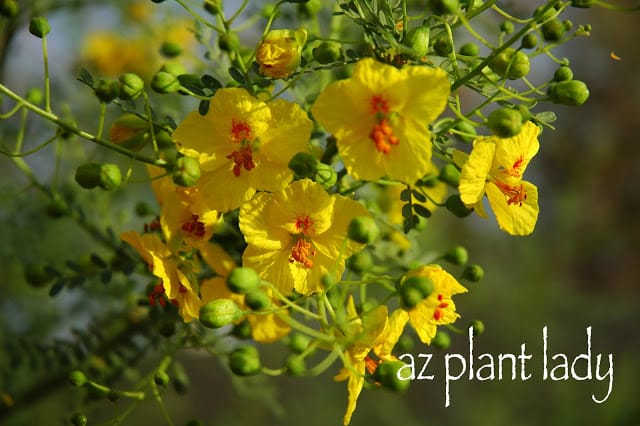
Desert Museum’ Flower
There Are Several Species of Palo Verde
There are three species of palo verde that are native to the desert Southwest; blue palo verde (Parkinsonia florida), formerly (Cercidium floridum), foothill palo verde (Parkinsonia microphylla), formerly (Cercidium microphyllum) and ‘desert museum’ palo verde (Parkinsonia x ‘Desert Museum’).
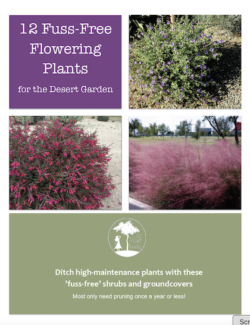
Another species of palo verde that is prevalent in the landscape are called palo brea (Parkinsonia praecox), formerly (Cercidium praecox). They have a dusty green trunk and branches that twist and turn. Their cold hardiness range is around 15 to 20 degrees F.
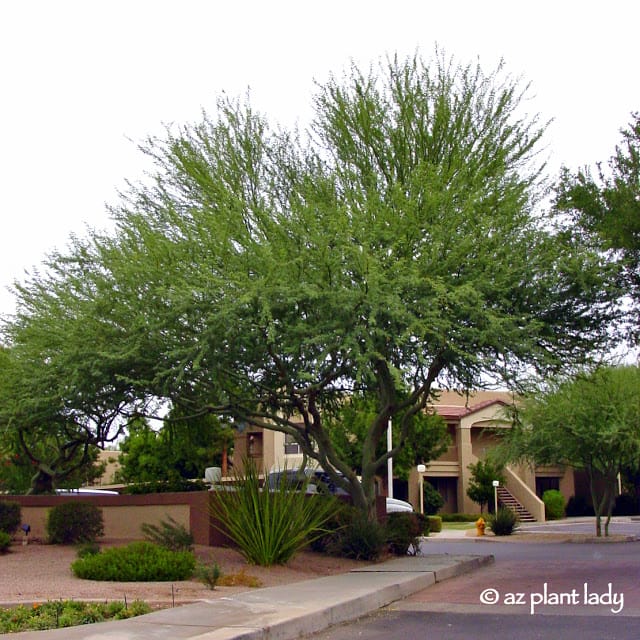
Iconic tree, Palo Brea
Palo Verde Landscape Uses
Palo verde trees serve as beautiful specimen trees where their green trunks, branch structure, and flowers serve as an attractive focal point in the landscape. They are drought tolerant, once established and provide lovely filtered shade year-round.
When deciding where to place your tree, be sure to take into account that they need a lot of room to grow, mature sizes are listed below.
Palo Verdes don’t do well when planted in grass and will decline over time. Locate away from swimming pools due to flower litter in the spring.
Because of their more massive thorns and branching tendency to point downwards, palo brea trees aren’t recommended in areas close to foot traffic.
Mature Sizes:
- Blue Palo Verde – 30 ft x 30 ft
- ‘Desert Museum’ Palo Verde – 30 ft high x 40 ft wide
- Palo Brea – 30 ft x 25 ft
- Foothills Palo Verde – 20 ft x 20 ft
As with many desert trees, Palo Verde trees have thorns, except for the ‘Desert Museum’ Palo Verde.
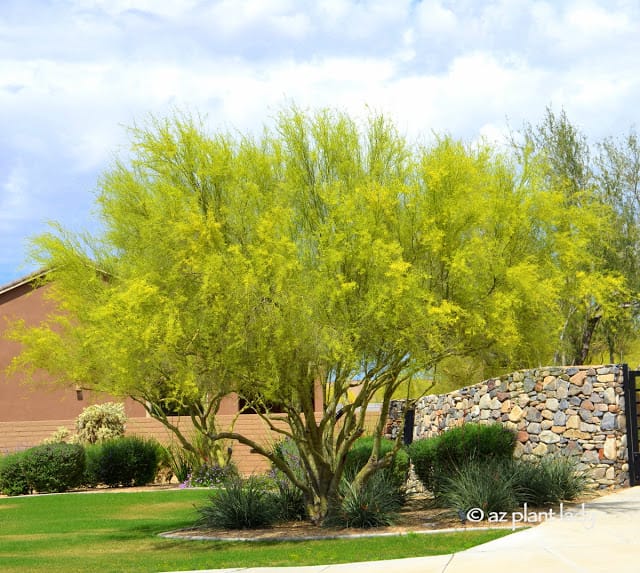
Foothills Palo Verde
Basic Palo Verde Maintenance
Pruning for Canopy Elevation and Structural Integrity:
Pruning Palo Verde trees in your desert Southwest garden is a crucial aspect of maintaining their health, aesthetics, and structural integrity. One of the primary objectives of pruning is to elevate the canopy, ensuring it remains well-balanced and visually appealing. This practice involves selectively trimming the lower branches to create a more elevated and open canopy. By doing so, you allow for better air circulation and light penetration, which can promote overall tree health and reduce the risk of disease.
Steering Clear of Hedging and Topping:
While pruning is essential, it’s equally vital to understand what not to do. Avoid two harmful practices: hedging and topping.
- Hedging: Hedging involves indiscriminate shearing or cutting of branches to create a uniform, artificial shape. This practice is highly discouraged for Palo Verde trees, as it not only compromises the tree’s natural beauty but also disrupts its growth patterns. Hedging can lead to dense, bushy growth with weaker, more susceptible branches.
- Topping: Topping is the severe cutting of the uppermost branches, often leaving stubs or bare trunks. This practice is detrimental to the tree’s health and stability. When Palo Verde trees are topped, they respond with a vigorous burst of new growth that tends to be weak and prone to breakage. Topped trees are also more susceptible to pests and diseases.
The Proper Tree Pruning Approach:
Instead, adopt a thoughtful and strategic approach to pruning your Palo Verde trees. Start by identifying dead, diseased, or damaged branches, and promptly remove them. This eliminates potential entry points for pests and diseases, promoting tree health.
Next, focus on elevating the canopy by selectively pruning lower branches. When selecting branches for removal, prioritize those with narrow crotches or those that cross and rub against each other, as these can weaken the overall structure.
Consider hiring a certified arborist or a professional tree service to ensure that your Palo Verde trees receive the care they deserve. These experts have the knowledge and experience to prune your trees correctly, preserving their natural form and promoting robust, healthy growth.
By following proper pruning practices and avoiding hedging and topping, you can help your Palo Verde trees thrive in your desert Southwest garden. A well-maintained Palo Verde tree not only adds to the beauty of your landscape but also provides valuable shade and habitat for local wildlife while remaining resilient in the harsh desert environment.
Palo Verde is My Favorite Tree
As a landscape manager, horticulturist and arborist, I have grown and maintained all of the palo verde species mentioned, and I truly enjoy them all. However, at home, I have 4 ‘Desert Museum’ trees.
In comparison to the other species, their trunks are a deeper green; they produce larger flowers, are thornless and grow very quickly in the desert. Also, they require little, if any, tree staking when planted. Simple amazing!







